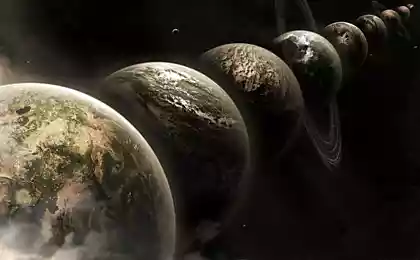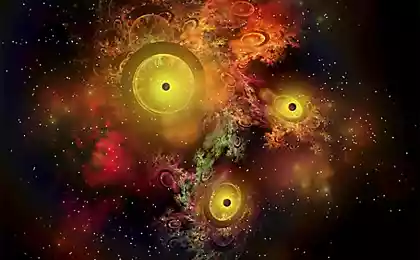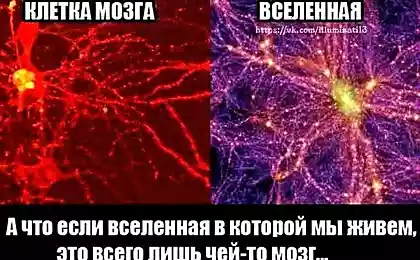611
Physics: we live in a giant hologram
Some physicists actually believe that the universe in which we live, may be a giant hologram. A scientific profession is becoming more popular. And most interesting is that this idea is not very similar simulation like the Matrix, but rather leads to the fact that although we think we live in a three dimensional universe, it can be just two dimensions. It's called the holographic principle.
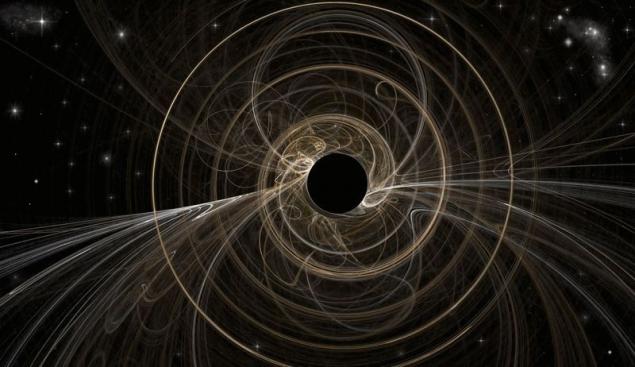
The idea is this: some distant two-dimensional surface contains all the data necessary for a complete description of our world — and, as in the hologram, the data is projected into three dimensions. Like the characters on TV, we live on a flat surface, which only seems deep.
Sounds absurd. But if physics come to the conclusion that their calculations are correct, all the major problems of physics — like the nature of black holes and reconciliation of gravity and quantum mechanics — will be much easier to solve. In short, the laws of physics have more meaning when written in two dimensions, not three.
"Among the majority of theoretical physicists this idea is not considered crazy," says Leonard Susskind, Stanford physicist, who first formally formed this idea decades ago. — She became a working everyday tool for solving problems of physics".
However, it is worth noting an important point. There is no direct evidence that our universe is actually a two-dimensional hologram. These calculations are not one and the same as a mathematical proof. Rather, they are intriguing suggestion that our universe may be a hologram. And while not all physicists are confident that we have a good way to test the idea experimentally.

Where did the idea that the universe may be a hologram?
Originally this idea came from a couple of paradoxes associated with black holes.
1. The paradox of information loss in a black hole
In 1974 Stephen Hawking discovered that black holes, contrary to popular belief, emit small amounts of radiation over time. Ultimately, when all the energy will flow out beyond the event horizon — the outer boundary of a black hole — a black hole should be solved forever.
However, this idea has led to the emergence of the problem of information loss in a black hole. For a long time it was believed that physically information can not be destroyed: all particles take the original form, or in case changes affect other particles, so the changes you can restore the original state of the particles.
In the framework of analogy, imagine a stack of documents that is fed to the shredder. Even if the documents are torn into tiny particles, they would still exist. It will be broken into small pieces but does not disappear, and over time the document can be reassembled. So you can find out that it was recorded. In fact, the same can be applied to the particles.
But there is a problem: if the black hole disappears, the information about each sussanna it is also the object seems to be disappeared.
One of the solutions proposed by Susskind and Dutch physicist Gerard ' t Goitom in the mid-90s, was the fact that when an object is drawn into the black hole, it leaves behind a kind of two-dimensional fingerprint, encoded in the event horizon. Later, when the radiation emerges from the black hole, it picks up fingerprints the data. Thus, information is not destroyed in reality.
The calculations showed that in a two-dimensional surface of a black hole can store enough information to fully describe all possible three-dimensional objects inside.
"The analogy that we both thought of independently, is something like a hologram — a two-dimensional piece of film on which to encode information about the three-dimensional region of space," says Susskind.
2. The problem of entropy
Was also the related problem of calculation of the amount of entropy in a black hole — i.e. the amount of disorder and randomness among the particles. In the 70-ies of Jacob, Bekenstein calculated that its entropy is limited and proportional to Planck two-dimensional area of the event horizon of a black hole.
"For systems of ordinary matter entropy is proportional to the volume, not the area", says Juan Maldacena, an Argentine physicist who participated in the study of the holographic principle. Eventually, he and others came to the conclusion that what looks like a three-dimensional object — a black hole — can be better understood in two dimensions.
As this idea has moved from black holes to the whole Universe?None of this proves that black holes are holograms. But almost immediately, says Susskind, physicists have recognized that consideration of the Universe as a two-dimensional object which only appears in three dimensions, can help to solve many of the deepest problems in theoretical physics. The mathematics of the theory works equally well regardless of, you say a black hole, the planet or the whole Universe.
In 1998 Maldacena demonstrated that hypothetical universe may be a hologram. His private hypothetical universe was the so-called anti-de-sitter space (in simple words, curved at large distances form, in contrast to our flat universe).
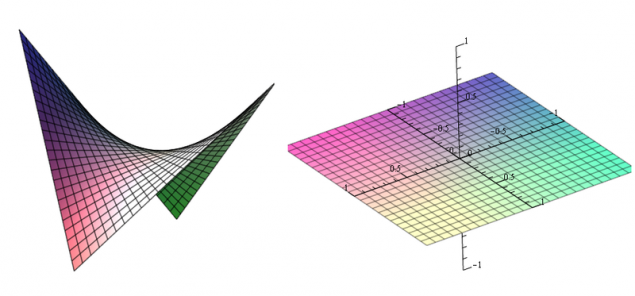
Moreover, when you look at this universe in two dimensions, he found a way to bring the incredibly popular idea of string theory is a broad theoretical field in which the basic building blocks of our Universe are one-dimensional strings rather than particles.
And more importantly, in the process, it brought together two incredibly important and separate concepts of physics in one theoretical framework. "The holographic principle has connected the theory of gravity with the theories of particle physics," says Maldacena.
The combination of these two basic ideas into one consistent theory (often called quantum gravity) remains one of the Holy Grails of physics. Of course, this also tells us that our universe is not hypothetical — it is a hologram.
Could our universe, in principle, be a hologram or is this idea only applies to a hypothetical? This remains the subject of fierce debate.
Lately there has been much theoretical work that led to the idea that the holographic principle can work for our Universe — including high-profile Austrian and Indian physicists, which was released in may.
As Maldacena, they also sought to apply the principle and to find similarities between disparate fields of quantum physics and gravitation theory. In our Universe, these two theories do not converge: they predict different results concerning the behavior of any individual particle.
But in the new work, physicists have calculated how these theories can predict the degree of entanglement is the strange quantum phenomenon in which the tiny state of two particles can be correlated so that a change in one particle will affect the other, even at a great distance. Scientists have found that examining a specific model of flat universe as holograms, they can get matching results from both theories.
However, although it is a bit closer to the universe, on which he worked Maldacena, the scientists worked only with one particular type of flat space, but their calculations did not take into account the time — only three spatial dimensions. Moreover, even if it was possible to apply directly to our Universe, it would show only that she may be a hologram.
How to prove that our universe is a hologram?The best type of evidence must begin with some testable predictions, displayed in the framework of the holographic theory. Physics experimenters could gather evidence to see whether the results are predictions. For example, the Big Bang theory predicted that we could find remnants of the energy coming from the Universe as a result of ill expansion 13.8 billion years ago — in 1960-years of the astronomers, this is what I found, in the form of the cosmic microwave background.
Currently there is no universal test that would provide solid evidence of this idea. However, some physicists believe that the holographic principle predicts a limit to how much information can contain a space-time, as our seemingly three-dimensional space-time is encoded in a limited number of two-dimensional information.
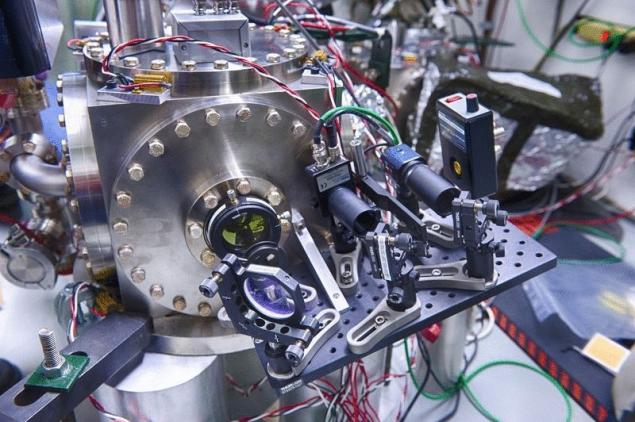
Craig Hogan of Fermilab uses a tool called Holometer, which needs to capture proof of the above. It relies on powerful lasers that are looking for the fundamental limit of information present in the space — time at ultra-small submicroscopic levels. If you find one, it will be proof that we live in a hologram.
Other physicists, including Susskind, do not believe in this experiment and say that he will not provide any evidence of the holographic principle.
Well, we live in a hologram. What's next?
Strictly speaking, nothing. The laws of physics by which you live your life will remain the same. Your house, dog, car, body will continue to be three-dimensional objects, which always seemed and was. But in a deep sense, this discovery will revolutionize our existence on a fundamental level.
Our daily life has no meaning that 13.8 billion years ago in a sudden and violent explosion from a single point of matter that formed our universe. But the discovery of the Big Bang remains an important tool in our understanding of the history of the Universe and understanding our place in the cosmos.
Similarly, the strange principles of quantum mechanics — entanglement, in which two remote particles somehow influence each other, do not affect our daily lives. You don't see the atoms and do not know what they are doing on the smallest level. But these principles enable us to access unexpected laws of nature.
Confirmation of the holographic principle will be the same. In life we may never even find out about a peculiar and contradictory fact that we live in a hologram. But this discovery will be an important step towards the full understanding of the laws of physics — which determines every action that you take.published
P. S. And remember, just changing your mind — together we change the world! ©
Source: hi-news.ru

The idea is this: some distant two-dimensional surface contains all the data necessary for a complete description of our world — and, as in the hologram, the data is projected into three dimensions. Like the characters on TV, we live on a flat surface, which only seems deep.
Sounds absurd. But if physics come to the conclusion that their calculations are correct, all the major problems of physics — like the nature of black holes and reconciliation of gravity and quantum mechanics — will be much easier to solve. In short, the laws of physics have more meaning when written in two dimensions, not three.
"Among the majority of theoretical physicists this idea is not considered crazy," says Leonard Susskind, Stanford physicist, who first formally formed this idea decades ago. — She became a working everyday tool for solving problems of physics".
However, it is worth noting an important point. There is no direct evidence that our universe is actually a two-dimensional hologram. These calculations are not one and the same as a mathematical proof. Rather, they are intriguing suggestion that our universe may be a hologram. And while not all physicists are confident that we have a good way to test the idea experimentally.

Where did the idea that the universe may be a hologram?
Originally this idea came from a couple of paradoxes associated with black holes.
1. The paradox of information loss in a black hole
In 1974 Stephen Hawking discovered that black holes, contrary to popular belief, emit small amounts of radiation over time. Ultimately, when all the energy will flow out beyond the event horizon — the outer boundary of a black hole — a black hole should be solved forever.
However, this idea has led to the emergence of the problem of information loss in a black hole. For a long time it was believed that physically information can not be destroyed: all particles take the original form, or in case changes affect other particles, so the changes you can restore the original state of the particles.
In the framework of analogy, imagine a stack of documents that is fed to the shredder. Even if the documents are torn into tiny particles, they would still exist. It will be broken into small pieces but does not disappear, and over time the document can be reassembled. So you can find out that it was recorded. In fact, the same can be applied to the particles.
But there is a problem: if the black hole disappears, the information about each sussanna it is also the object seems to be disappeared.
One of the solutions proposed by Susskind and Dutch physicist Gerard ' t Goitom in the mid-90s, was the fact that when an object is drawn into the black hole, it leaves behind a kind of two-dimensional fingerprint, encoded in the event horizon. Later, when the radiation emerges from the black hole, it picks up fingerprints the data. Thus, information is not destroyed in reality.
The calculations showed that in a two-dimensional surface of a black hole can store enough information to fully describe all possible three-dimensional objects inside.
"The analogy that we both thought of independently, is something like a hologram — a two-dimensional piece of film on which to encode information about the three-dimensional region of space," says Susskind.
2. The problem of entropy
Was also the related problem of calculation of the amount of entropy in a black hole — i.e. the amount of disorder and randomness among the particles. In the 70-ies of Jacob, Bekenstein calculated that its entropy is limited and proportional to Planck two-dimensional area of the event horizon of a black hole.
"For systems of ordinary matter entropy is proportional to the volume, not the area", says Juan Maldacena, an Argentine physicist who participated in the study of the holographic principle. Eventually, he and others came to the conclusion that what looks like a three-dimensional object — a black hole — can be better understood in two dimensions.
As this idea has moved from black holes to the whole Universe?None of this proves that black holes are holograms. But almost immediately, says Susskind, physicists have recognized that consideration of the Universe as a two-dimensional object which only appears in three dimensions, can help to solve many of the deepest problems in theoretical physics. The mathematics of the theory works equally well regardless of, you say a black hole, the planet or the whole Universe.
In 1998 Maldacena demonstrated that hypothetical universe may be a hologram. His private hypothetical universe was the so-called anti-de-sitter space (in simple words, curved at large distances form, in contrast to our flat universe).

Moreover, when you look at this universe in two dimensions, he found a way to bring the incredibly popular idea of string theory is a broad theoretical field in which the basic building blocks of our Universe are one-dimensional strings rather than particles.
And more importantly, in the process, it brought together two incredibly important and separate concepts of physics in one theoretical framework. "The holographic principle has connected the theory of gravity with the theories of particle physics," says Maldacena.
The combination of these two basic ideas into one consistent theory (often called quantum gravity) remains one of the Holy Grails of physics. Of course, this also tells us that our universe is not hypothetical — it is a hologram.
Could our universe, in principle, be a hologram or is this idea only applies to a hypothetical? This remains the subject of fierce debate.
Lately there has been much theoretical work that led to the idea that the holographic principle can work for our Universe — including high-profile Austrian and Indian physicists, which was released in may.
As Maldacena, they also sought to apply the principle and to find similarities between disparate fields of quantum physics and gravitation theory. In our Universe, these two theories do not converge: they predict different results concerning the behavior of any individual particle.
But in the new work, physicists have calculated how these theories can predict the degree of entanglement is the strange quantum phenomenon in which the tiny state of two particles can be correlated so that a change in one particle will affect the other, even at a great distance. Scientists have found that examining a specific model of flat universe as holograms, they can get matching results from both theories.
However, although it is a bit closer to the universe, on which he worked Maldacena, the scientists worked only with one particular type of flat space, but their calculations did not take into account the time — only three spatial dimensions. Moreover, even if it was possible to apply directly to our Universe, it would show only that she may be a hologram.
How to prove that our universe is a hologram?The best type of evidence must begin with some testable predictions, displayed in the framework of the holographic theory. Physics experimenters could gather evidence to see whether the results are predictions. For example, the Big Bang theory predicted that we could find remnants of the energy coming from the Universe as a result of ill expansion 13.8 billion years ago — in 1960-years of the astronomers, this is what I found, in the form of the cosmic microwave background.
Currently there is no universal test that would provide solid evidence of this idea. However, some physicists believe that the holographic principle predicts a limit to how much information can contain a space-time, as our seemingly three-dimensional space-time is encoded in a limited number of two-dimensional information.

Craig Hogan of Fermilab uses a tool called Holometer, which needs to capture proof of the above. It relies on powerful lasers that are looking for the fundamental limit of information present in the space — time at ultra-small submicroscopic levels. If you find one, it will be proof that we live in a hologram.
Other physicists, including Susskind, do not believe in this experiment and say that he will not provide any evidence of the holographic principle.
Well, we live in a hologram. What's next?

Strictly speaking, nothing. The laws of physics by which you live your life will remain the same. Your house, dog, car, body will continue to be three-dimensional objects, which always seemed and was. But in a deep sense, this discovery will revolutionize our existence on a fundamental level.
Our daily life has no meaning that 13.8 billion years ago in a sudden and violent explosion from a single point of matter that formed our universe. But the discovery of the Big Bang remains an important tool in our understanding of the history of the Universe and understanding our place in the cosmos.
Similarly, the strange principles of quantum mechanics — entanglement, in which two remote particles somehow influence each other, do not affect our daily lives. You don't see the atoms and do not know what they are doing on the smallest level. But these principles enable us to access unexpected laws of nature.
Confirmation of the holographic principle will be the same. In life we may never even find out about a peculiar and contradictory fact that we live in a hologram. But this discovery will be an important step towards the full understanding of the laws of physics — which determines every action that you take.published
P. S. And remember, just changing your mind — together we change the world! ©
Source: hi-news.ru











